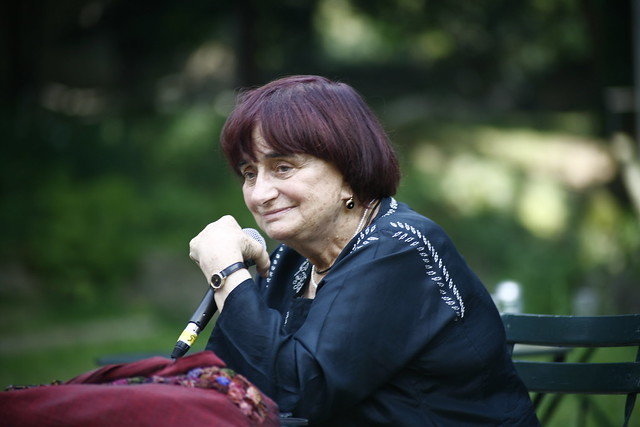.
Jean (Yanko) Varda (11 September 1893, in Smyrna (now İzmir) - 10 January 1971) was an artist. He was of mixed Greek and French descent. As a child he was known as a prodigy, and received commissions to paint portraits of prominent Athenians.[1]
At 19, Varda moved to Paris where he met Picasso and Braque and lost all interest in the academic style of painting he had been pursuing until that time.[1] He moved to London during World War I, became a ballet dancer,[2] and began to make friends with members of the avant garde in London.[2][3]
By 1922 Varda was back in Paris and had returned to painting.[4] Beginning in 1923 Varda spent most of his summers in Cassis, in the south of France, where he welcomed a number of well-known people to his homes including, in addition to Braque and Miró, Derain, Max Ernst, Roger Fry, Clive Bell, Duncan Grant, Gerald Brenan and others.[4] By the mid 1920s he was spending most of his winters in London.[5][6]
During the 1930s Varda developed a type of mosaic that involved the use of pieces of broken mirrors. He would scratch the backs of the pieces of mirror, then paint bright colors in the scratches so the paint showed through to the front of the mirror. He would then glue the pieces of mirror to a board, which he had prepared with a gritty gesso mixture.[5]
Varda exhibited his work in London and Paris before leaving for New York in 1939, where his work was exhibited at the Neumann-Willard Gallery.[7] In 1940 he moved to Anderson Creek, in Big Sur, California, and after that to Monterey, about 40 miles north of Big Sur. In late 1943 he persuaded the writer Henry Miller to move to Big Sur. In 1947 Miller wrote an admiring profile of Varda called Varda the Master Builder, which was published by Circle Magazine, an avant garde art and literary magazine produced in Berkeley by George Leite. During the war years Varda’s house in Monterey became a virtual salon for artists, writers and other creative people.[8] Through Henry Miller Varda met the writer Anaïs Nin. Varda and Nin became close friends and Nin would write about Varda frequently.[9] In addition, her novel "Collages" includes a slightly fictionalized profile of Varda.[10]
By 1943 Varda was shifting over to collages from his earlier mosaic/mirror pictures. The collage, which would typically combine scraps of cloth and bits of paper with paint on a board, would remain his favored medium for the rest of his life.[11]
In 1946 Varda taught in the art department at a Summer Institute at Black Mountain College, an experimental school in rural North Carolina.[8][12] During the late 1940s and early 1950s Varda taught at the California School of Fine Arts (now the San Francisco Art Institute).
In approximately 1948 Varda and British-born artist Gordon Onslow Ford acquired an old ferryboat, called the Vallejo. They permanently moored the Vallejo in Sausalito, just across the Golden Gate Bridge from San Francisco, and remodeled it into a studio for Onslow-Ford and a studio and living quarters for Varda, using materials scavenged from a closed-down wartime shipbuilding operation.[13] The writer and Zen Buddhist popularizer Alan Watts took over Onslow-Ford’s space on the ferryboat in 1961.[14]
Varda turned the Vallejo into a kind of salon - he was an excellent cook, and would regale guests with stories at dinners. His costume parties were famous. On Sunday afternoons he would take friends out on one of his homemade sailboats. Throughout his life he continued to create collages.[14]
In 1967 he was the subject of a short documentary film by his niece, the filmmaker Agnès Varda, entitled "Uncle Yanco."
Varda died after suffering a heart attack upon arriving by plane in Mexico City, where he had gone to visit a friend.[14]
Varda was married three times: to Dorothy Varda during the 1920s;[6] to Virginia Barclay Varda from 1940 until approximately 1947; and to Chryssa Vardea Mavromichali, from 1955 until 1958. He is survived by a daughter, Vagadu, who was born to Varda and his wife Virginia in 1946, and by a granddaughter, Joui Turandot.
References
^ a b Marin Independent Journal, Interview with Jean Varda, August 5, 1950)
^ a b Stella Bowen, Drawn from Life, Collins, United Kingdom, 1940, p. 39
^ The Journals of Mary Butts, ed. Nathalie Blondel, Yale, New Haven 2002, pp. 98, 100,104,106.
^ a b Roland Penrose, Scrap Book, Rizzoli, New York, 1981, p. 28.
^ a b Julian Trevelyan, Indigo Days, (originally published MacGibbon & Kee, London, 1957), revd. Ed. Scolar Press, Aldershot, 1996, pp. 59-63
^ a b Gerald Brenan, Personal Record, Knopf, New York 1975, p.162
^ Art News, 1939
^ a b Susan Landauer, The San Francisco School of Abstract Expressionism, University of California, Berkeley, 1996, p.48
^ The Diary of Anaïs Nin, Volume 6,ed. Gunther Stuhlmann (First Harvest/HBJ edition, United States, 1977, pp. 105, 132,165,183.
^ Anaïs Nin, Collages, Swallow Press, Chicago, 1964, pp. 59-71.
^ Time Magazine, 30 August 1943
^ Mary Emma Harris, The Arts at Black Mountain College, MIT Press, Cambridge, Mass. 1987
^ Annie Sutter, The Vallejo Collage, The Sausalito Historical Society and The Ferryboat Vallejo Preservation Project
^ a b c Alan Watts, In My Own Way, an Autobiography, New World Library, Novato, California (Originally published by Pantheon Books, 1972), 300-304
| Ancient Greece
Science, Technology , Medicine , Warfare, , Biographies , Life , Cities/Places/Maps , Arts , Literature , Philosophy ,Olympics, Mythology , History , Images Medieval Greece / Byzantine Empire Science, Technology, Arts, , Warfare , Literature, Biographies, Icons, History Modern Greece Cities, Islands, Regions, Fauna/Flora ,Biographies , History , Warfare, Science/Technology, Literature, Music , Arts , Film/Actors , Sport , Fashion --- |
From Wikipedia, All text is available under the terms of the GNU Free Documentation License


